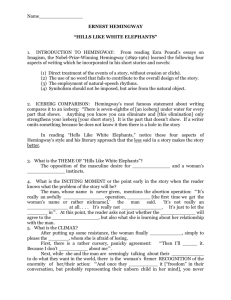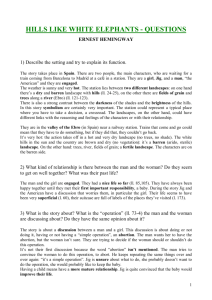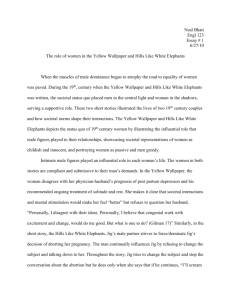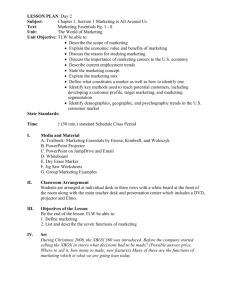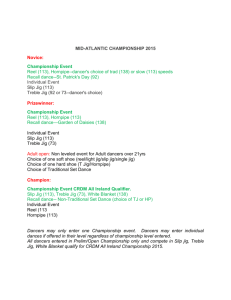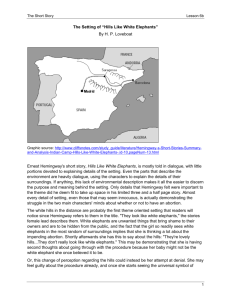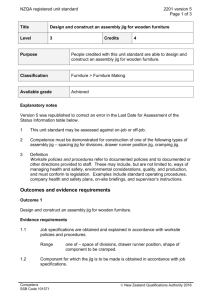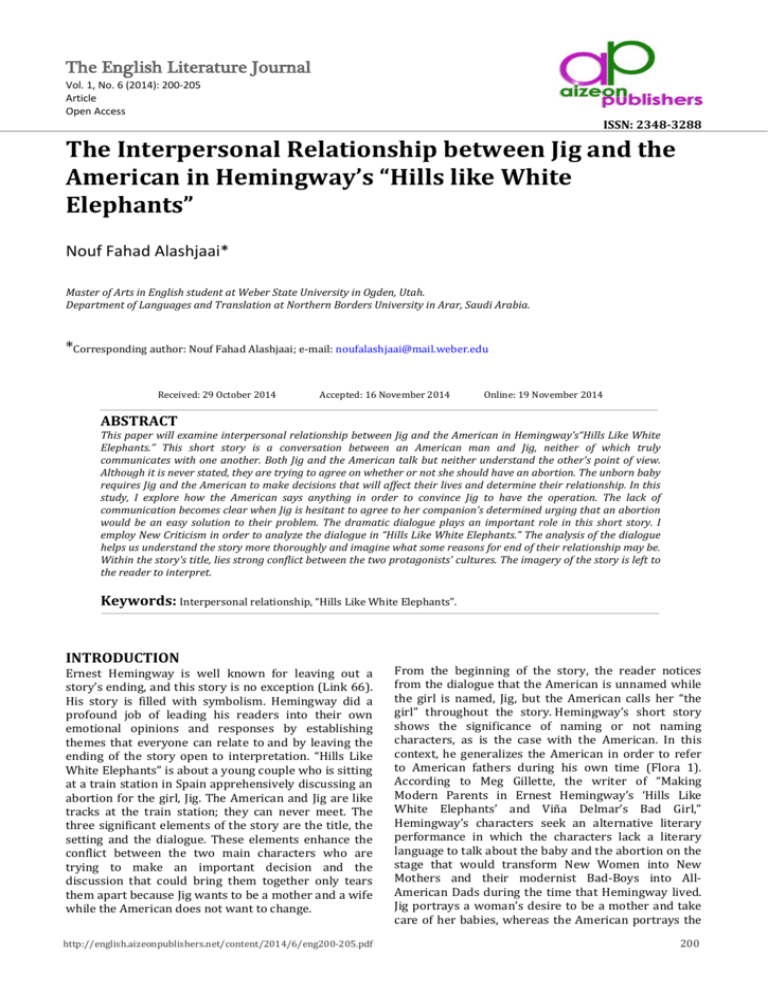
The English Literature Journal
Vol. 1, No. 6 (2014): 200-205
Article
Open Access
ISSN: 2348-3288
The Interpersonal Relationship between Jig and the
American in Hemingway’s “Hills like White
Elephants”
Nouf Fahad Alashjaai*
Master of Arts in English student at Weber State University in Ogden, Utah.
Department of Languages and Translation at Northern Borders University in Arar, Saudi Arabia.
*Corresponding author: Nouf Fahad Alashjaai; e-mail: noufalashjaai@mail.weber.edu
Received: 29 October 2014
ABSTRACT
Accepted: 16 November 2014
Online: 19 November 2014
This paper will examine interpersonal relationship between Jig and the American in Hemingway’s“Hills Like White
Elephants.” This short story is a conversation between an American man and Jig, neither of which truly
communicates with one another. Both Jig and the American talk but neither understand the other's point of view.
Although it is never stated, they are trying to agree on whether or not she should have an abortion. The unborn baby
requires Jig and the American to make decisions that will affect their lives and determine their relationship. In this
study, I explore how the American says anything in order to convince Jig to have the operation. The lack of
communication becomes clear when Jig is hesitant to agree to her companion’s determined urging that an abortion
would be an easy solution to their problem. The dramatic dialogue plays an important role in this short story. I
employ New Criticism in order to analyze the dialogue in “Hills Like White Elephants.” The analysis of the dialogue
helps us understand the story more thoroughly and imagine what some reasons for end of their relationship may be.
Within the story's title, lies strong conflict between the two protagonists' cultures. The imagery of the story is left to
the reader to interpret.
Keywords: Interpersonal relationship, “Hills Like White Elephants”.
INTRODUCTION
Ernest Hemingway is well known for leaving out a
story’s ending, and this story is no exception (Link 66).
His story is filled with symbolism. Hemingway did a
profound job of leading his readers into their own
emotional opinions and responses by establishing
themes that everyone can relate to and by leaving the
ending of the story open to interpretation. “Hills Like
White Elephants” is about a young couple who is sitting
at a train station in Spain apprehensively discussing an
abortion for the girl, Jig. The American and Jig are like
tracks at the train station; they can never meet. The
three significant elements of the story are the title, the
setting and the dialogue. These elements enhance the
conflict between the two main characters who are
trying to make an important decision and the
discussion that could bring them together only tears
them apart because Jig wants to be a mother and a wife
while the American does not want to change.
http://english.aizeonpublishers.net/content/2014/6/eng200-205.pdf
From the beginning of the story, the reader notices
from the dialogue that the American is unnamed while
the girl is named, Jig, but the American calls her “the
girl” throughout the story. Hemingway’s short story
shows the significance of naming or not naming
characters, as is the case with the American. In this
context, he generalizes the American in order to refer
to American fathers during his own time (Flora 1).
According to Meg Gillette, the writer of “Making
Modern Parents in Ernest Hemingway’s ‘Hills Like
White Elephants’ and Viñ a Delmar’s Bad Girl,”
Hemingway’s characters seek an alternative literary
performance in which the characters lack a literary
language to talk about the baby and the abortion on the
stage that would transform New Women into New
Mothers and their modernist Bad-Boys into AllAmerican Dads during the time that Hemingway lived.
Jig portrays a woman’s desire to be a mother and take
care of her babies, whereas the American portrays the
200
Nouf Fahad Alashjaai / The Eng Lit J. 2014, 1(6): 200-205
Bad-Boys because he wants to ignore his
responsibilities since he wants her to have the abortion
(Gillette 52). By having the abortion, the American
would not need to change his lifestyle. The American
Bad-Boys did not want to take on the responsibilities of
being All-American Dads.
Throughout “Hills Like White Elephants,” the narrator
chooses to omit the words abortion and baby, which
leads the couple to miscommunicate and to emotionally
drift apart. Hemingway’s story discusses whether or
not the baby should be born. The baby is the product of
their relationship and having it will change their
lifestyle (Bethea 90). The first allusion of the pregnancy
and the abortion appears in the American’s dialogue:
“I know you would not mind it, Jig.”
“You don’t have to be afraid”
“I know a lot of people that have done it.” (Hemingway
297)
The American does not seem to care about Jig’s opinion.
He only attempts to convince her to have the abortion.
Even though the word abortion is never mentioned in
these lines, the reader is then able to cross the T’s and
dot the I’s. The reader notices that there is a gap
between the couple, which leads them into conflict and
eventually separates them.
In addition to the omission of the word abortion, “white
elephants” in the title is significant because these
words portray different images for different cultures
(Portch 85). For example, it portrays a bad image in
Middle-Eastern culture, whereas in European and
Indian cultures, it has a positive meaning. In MiddleEastern culture, the image of elephants reflects a big
and clumsy creature, which is an unfavorable image
and further reinforces Jig’s inferiority. In Indian culture,
white elephants symbolize the status of kings because,
during the 19th century, Indian kings used white
elephants to commute and explore their realm (Feudge
153). In American culture, a white-elephant gift means
a second-hand gift. However, in “Hills Like White
Elephants,” the white elephants symbolize the unborn
baby, which the American considers a white elephant
gift that will alter his lifestyle. He does not want to
receive this gift because, if he accepts it, he has to take
care of it. A white elephant has also been defined as an
item that is worthless to one but priceless to another. In
the case of Hemingway’s couple, the baby represents
something of no apparent value to the man yet
priceless to the girl (Bauer 130).According to Bronwen
Thomas, the writer of Fictional Dialogue: Speech and
Conversation in the Modern and Postmodern Novel, the
readers have different levels of understanding the
dialogue, and each reader interprets the metaphors and
figures of speech based on his or her cultural
background (Thomas 57). The American might have a
Middle-Eastern opinion that Jig is a clumsy creature in
her pregnancy, and in American culture, the pregnancy
and the baby are like the white-elephant gifts that the
American does not want to receive or keep (Bauer
130). The white elephant term is significant because it
http://english.aizeonpublishers.net/content/2014/6/eng200-205.pdf
is the tension in the story’s plot, which widens the gap
between the couple.
One reading of the story is that hills can be a symbol of
fertility, and Jig’s unborn baby can be regarded as a
white elephant, and the whiteness of the elephant
might suggest the purity of that baby. Within the title
and the story, the metaphor is not a source of pleasure.
It is more than just a line of dialogue; the title is the
main conflict as well as a metonymy for the story. The
title is full of symbolism, which sheds light on the
conflict regarding the unborn baby. The reader
questions the significance of her smile when she says,
“Hills Like Elephants.” To answer this question, the
reader has to view the story’s situation as a dramatic
irony. The title itself contains a significant meaning that
is enough to aid the reader’s understanding of the
narrative. Behind the phrase “Hills Like White
Elephants,” a couple of layers of significance emerge.
The hills might represent Jig’s dream of a family
relationship. The American’s cold response to Jig’s
smile shows that his relationship with Jig will not
change into a solid relationship of family. The American
has little empathy for Jig’s smile when she says white
elephants. The frequent statement, “Hills Like White
Elephants,” signifies Jig’s weak situation and their lack
of communication. Since the American wants her to
have the abortion, her smile shows her weak situation.
She cannot argue with him, and instead of saying that
she wants the baby, she projects her dreams onto the
hills by mentioning that they are like white elephants.
The word Hill in the title also refers to a pregnant
woman lying on her back and her womb becomes high
like a hill. In her conversation with the American, Jig
says, “They are lovely hills,” which implies that she is
projecting her desires and emotions from the baby
when she refers to the hills as lovely (Hashmi 73).
While Jig talks to the American she observed the
landscape surrounding them and imposes her desires
into it:
The girl was looking off at the line of hills. They were
white in the sun and the country was brown and dry.
“They look like white elephants,” she said.
“I’ve never seen one,” the man drank his beer. “No, you
wouldn’t have.”
“I might have,” the man said. “just because you say I
wouldn’t have doesn’t prove anything.” (Hemingway 296)
Their words indicate that there is no emotional
development. Their words suggest that the baby is their
first. The metaphor here refers to their different points
of view; Jig loves the hills and the unborn baby, and the
American sees the baby as something that will destroy
his lifestyle. Whatever their relationship, their love
affair will not continue (Wyche 58-59). The American
told her, “I’ve never seen one,” referring to the unborn
baby. His response shows that he is not interested to be
a father. The couple has different desires and plans to
live their own lifestyles. As they continue to talking,
they find no resolution to their situation, so their
201
individual desires
emotionally.
and
Nouf Fahad Alashjaai / The Eng Lit J. 2014, 1(6): 200-205
plans
separate
them
Throughout the story, the American uses words to
manipulate Jig, which demonstrates how he objectifies
and depersonalizes her. Jig is worried that if she has the
abortion he will still leave her. Both of them manipulate
each other when they talk about the abortion. She
asked him in different ways if he would stay with her
and if he will still love her after the abortion. Instead of
answering her questions, he continues to encourage
her to have it and he will be the same:
“And if I do it you’ll be happy and things will be like they
were and you’ll love me?”
“I love you now. You know I love you.”
“I know. But if I do it, then it will be nice again if I say
things are like white elephants, and you’ll like it?”
(Hemingway 298)
In reply, Jig uses different ways of manipulation by
asking him multiple questions like: “If I do it you’ll be
happy and things will be like they were and you’ll love
me?” This statement gives the reader a sense that
although the American is nice and caring, Jig realized
that the American is able to sacrifice her and the baby
in order to keep his lifestyle and not change. Even her
dialogue reinforces her inferiority because she sounds
like a child. She thinks the only way to be happy is to
please the American. Jig portrays the weak role of
women. One of the reasons why she feels the need to
make the American happy lies in her fear of losing him,
and this fear is apparent in the question she asked the
American. Jig is willing to sacrifice her own feelings for
his, if it makes him happy. She struggles to make a
decision. She also begins to lower her self- esteem in
order to please him. “If I do it you won’t ever
worry...then I’ll do it because I don’t care about me”
(298). This quote clearly shows how she sacrifices her
self-respect just to keep the American pleased. The
reader sees her through their dramatic dialogue when
she puts his feelings over hers when making
decisions. The American is constantly pressing Jig to
acknowledge that the operation is simple and is only
“to let the air in” (297), but then he contradicts himself
and says, “If you don’t want to you don’t have to. I
wouldn’t have you do it if you didn’t want to” (297).
Nevertheless, he concludes, “But I know it’s perfectly
simple” (298).When the American realizes that Jig does
not share his view, he manipulates her by seeming like
he is truly there for her. He tries to reassure and
comfort her by repeating: “If you don’t want to, you
don’t have to. I wouldn’t have you do it if you didn’t
want to” (298). Throughout their discussion, the
American tries to simplify the abortion, and this apathy
tears them apart. Jig eventually realizes that he is
sacrificing her and the baby in order to keep his
lifestyle.
In a close reading, the reader can see that there is much
hidden under both characters’ personas. Trying to
convince Jig to have an abortion, the American attempts
to show himself as a reasonable and rational person.
http://english.aizeonpublishers.net/content/2014/6/eng200-205.pdf
However, later in the text, it becomes clear that he is a
hypocritical and selfish person and two specific
examples demonstrate this:
“You’ve got to realize,” he said, “that I don’t want you to
do it if you don’t want to. I’m perfectly willing to go
through with it if it means anything to you.”
“Doesn’t it mean anything to you? We could get along.”
“Of course it does. But I don’t want anybody but you. I
don’t want anyone else. And I know it’s perfectly simple.”
“Yes, you know it’s perfectly simple.”
“It’s all right for you to say that, but I do know it” (298).
In addition, when Jig speaks about anything, he
immediately changes the subject and starts replying
irrelevantly to what she says:
The girl looked across at the hills.
“They’re lovely hills,” she said. “They don’t really look like
white elephants. I just meant the coloring of their skin
through the trees.”
“Should we have another drink?”
“All right.” (297)
Through his words, it is apparent he does not care
about the side effects of the abortion. He only focused
on the abortion itself, but not on the risk that Jig might
faces soon after the abortion or along her life. The
American then tells Jig: “We can have everything”
(298). Jig tells him: “No, it isn’t. And once they take it
away, you never get it back” (298). The fact that she
would be giving up a child is one thing, but the difficult
decision for her at this point is the risk that she would
put herself in. if she chose to have the abortion and
sacrifice herself and the baby, she would not forgive the
American later on. According to Howard Hashmi, the
girl decides to have the abortion, but she will not
tolerate the American afterwards because he exploited
her in her weakness and pushed her to have the
abortion (Hashmi 72).
When the American and Jig enter the bar, Jig takes off
her hat, which symbolizes that she bares her feelings.
Jig tries to relax in order to discuss their relationship
and their unborn baby’s future. Her nonverbal gestures
reflect her feelings since they speak in metaphors. As
the couple starts discussing their problems, they begin
drinking licorice-flavored alcohol because they are
unable to face each other directly. Additionally,
drinking alcohol is another way for them to run away
from their problems. Because they want to avoid the
direct communication that might help them to make a
decision, they prefer to talk under the influence of
alcohol. Through their discussion while they drinking
alcohol, Jig’s insecurity about the American’s feelings
for her becomes apparent to the reader. The things he
suggests make her insecure: “Look at things and try
new drink”(Hemingway 297). His dialogue suggests
that he is trying to ignore Jig and wants to drink liquor
and flee his problems. Jig is unlikely to argue anymore
“Try new things” suggests try new lifestyles and
relationships. She gives up and wants to separate.
202
Nouf Fahad Alashjaai / The Eng Lit J. 2014, 1(6): 200-205
As the dramatic dialogue continues, the reader
understands the lack of communication between the
two. They talk to each other, but their personalities are
as complicated as their relationship. The American tries
to smooth the tension by saying, ‘‘Well, let’s try to have
a fine time.’’ The girl replies, ‘‘All right, I was trying. I
said the mountains looked like white elephants. Wasn’t
that bright?’’ They just want to take a break from the
argumentative dialogue because they are not able to
reach a conclusion that satisfies the two (Benthea 90).
Soon after this statement, Jig is apparently
powerlessness because she repeats “please.” She says,
“Would you please please please please please please
please stop talking?” (Hemingway 299) Alone with the
American, her words symbolize and emphasize her
weakness. She is unable to think under his pressure
whether or not to have the abortion. His pressure
agitates her because her pleas also show the climax
reaches its peak at this point in their conversation
(Benthea 91). The couple is unable to clearly make a
decision. It is only Jig who has to sacrifice the baby in
order to please the American, which makes their
relationship unbalanced, and this terminates their
relationship (Link 68).
The existing relationship between Jig and the American
will eventually deteriorate. Although several outcomes
are possible after the story, there are three scenarios
most likely to happen: Jig will have the abortion and
stay with the American; Jig will have the abortion and
leave the American; or Jig will not have the abortion,
but the American leaves her. Many scholars argue that
the story ends with the girl deciding to have the
abortion but not resuming her life with the American.
After the abortion, she might not be able to tolerate
him. David Wyche states that critics continue to
disagree over the fate of Jig’s unborn baby (Wyche 57).
One of the critics, Timothy O’Brien, sees the outcome of
the couple’s journey as “bleak and infertile.” (Hashmi
54) Their destination of Madrid is also ironic because of
the name’s similarity to madre, the Spanish word for
mother (Hashmi 64). Wyche suggests that when the
American says, “Look at things and try new drinks,” he
is referring to their old life and that their feelings for
one another will not be the same anymore. After Jig has
the abortion, the American might seek a life, and he
might have a new girlfriend since Jig would not be able
to tolerate him (Wyche 58).
Even though the critics continue discussing the
ambiguous possible endings, they all agree that the
unborn baby is the disagreement between the man and
the girl because the American believes the baby is a
burden on them; however Jig metaphorically wants the
baby and she sees the baby just like licorice-flavored
alcohol. Literary, as they order more drinks, Jig
observes that her new beverage tastes like licorice: is
not only a kind of alcohol, but it also stands for the
things Jig has waited so long for:
“It tastes like licorice,” the girl said and put the glass
down.
”That’s the way with everything.”
http://english.aizeonpublishers.net/content/2014/6/eng200-205.pdf
”Yes,” said the girl. “Everything tastes of licorice.
Especially all the things you’ve waited so long for, like
absinthe.”
”Oh, cut it out.”
”You started it,” the girl said. “I was being amused. I was
having a fine time.” (Hemingway 297)
According to Jig, once they get what they have waited
so long for, that thing may lose its appeal. Even though
Jig does not specifically reference the baby, she is still
implying that the baby is the subject of her speech. The
American, perhaps annoyed by her analogy, replies that
everything tastes of licorice. Jig agrees that his
statement is true, and continues to say, “Especially all
the things you’ve waited so long for, like absinthe”
(Hemingway 297). Here, Jig attempts to communicate
that everything she longs for, or finds a solution for,
leaves her feeling bitter in the end (Stien 240).
At the ending of the story, the American asks, “Do you
feel better?” Jig responds,” There is nothing wrong with
me. I feel fine” (Hemingway 299). Naturally, the readers
will be in a state of suspense. The open end offers the
readers a space in which to participate. Hemingway is
well-known for using unclear endings, which was a new
technique at his time. This statement shows that a
decision has been reached, but leaving it unnamed,
whether or not she will have the baby or have the
abortion, the word “fine” show the reader the
ambiguous end that reflect how the couple are
emotionally apart. “Fine” is ambiguous, they are neither
able to communicate literary nor emotionally.
Along with miscommunication that suggest Jig and the
American will end their relationship with breaking up.
Jig at the beginning of her relationship with the
American cared only about the economic statue;
however, they struggled because each of them adopted
different ideas of lifestyle. Jig will also lose the
economic status that she gained with the American.
Hemingway’s
handling
of
characterization
differentiates the male and female characters and
demonstrates how his characters are all victims of
economic circumstance. This victimizing of the
characters is a significant point in “Hills Like White
Elephants.” Jig was a victim of the American and her
economic circumstance. If the American loved her, he
would take responsibility of the baby. If the girl chooses
to have the baby, she will lose all the freedom to travel,
drink and socialize (Adams 88-89). Jig struggled to
make the decision that will change her future. She must
choose between the old and the new lifestyles. It is hard
for her to free herself from old habits that consist of
taking no responsibility as a mother should. At the
same time, she wants a man who has money and is
from the upper-middle class or higher in order to
provide her with the entertainment that she wants.
Even though Jig was the American’s good-time, their
licorice drink shows that he is no longer attracted to
her, nor she attracted to him. Their relationship is
faded and he started to be bored since Jig is pregnant.
She definitely realizes she needs to change. She walks
203
Nouf Fahad Alashjaai / The Eng Lit J. 2014, 1(6): 200-205
to the end of the station and looks upon the fertile side
of the valley and comments, “and we could have all
this.” She even says the alcohol tastes like licorice, that
everything tastes the same, and she’s getting tired of
her same old life. Even though she wants to change,
something is holding her back from doing so, perhaps
her old ways. Jig was the American’s good-time girl, but
the American finds her boring because she is pregnant:
“Then what will we do afterward?”
“We’ll be fine afterward. Just like we were before.”
“What makes you think so?”
“That’s the only thing [the pregnancy] that bothers us. It’s
“The only thing that’s made us unhappy.” (Hemingway
297)
Things between Jig and the American will never be
“fine” again. Jig wants the role of wife and the role of
the mother as well, but her exceptions have
changed. She would have the abortion and live with the
painful memory of an abortion that the American
forced upon her (Hashmi 77). She wants the American
and the baby, but the American only wants his lifestyle.
This miscommunication tears the couple apart.
Even though the story does not begin with a
description of the scenery, it brings the readers into the
scene by describing their relationship. This description
allows the reader to imagine what has happened
between the man and the girl before the story’s
beginning. The writer uses the train station as a setting
to portray the human condition in this story. The train
station, a common ground or meeting place, represents
the relationship between the American and Jig since he
does not give the topic any of his attention and he talks
about a private matter in an unsuitable place. The
tracks leading in and out of the station describe the
emotional pathways each of them will take. The
American is almost exactly opposite of Jig, free spirited
and unwilling to change. She has to choose between her
love for the American and her love for her unborn child.
The American tries to convince Jig that there is no harm
in what she is considering. He tries to calm Jig by telling
her, “We’ll be fine afterwards, just like we were before”
(Hemingway 297). Jig is not convinced nor is she as
confident or as willing as the American to rush off into
such a serious decision. Even though Jig is silent, her
silence when the American was talking to her speaks
volumes. She began to realize that whether or not she
terminates her pregnancy, they can never be like they
were before (Wyche 60). In addition, the river,
mountains, hills, trees, banks, valley, elephants, cloud,
traveling, bags, station, track, train, pubs, curtain, all
contradict each other. Nature represents the inner state
of Jig. She is ready to become a mother, but traveling
suggests that the American is not ready yet. He needs
some freedom and does not want to become a father.
These people are absolutely different from each other.
The white color in this story also has a significant role.
It might symbolize life, and cleanliness, meanwhile the
brownness and dryness of the country symbolize
suffering, hopelessness, grief and death. Probably these
http://english.aizeonpublishers.net/content/2014/6/eng200-205.pdf
colors within the orientation symbolize Jig’s suffering
Jig and show how her dreams and wishes of having the
baby are dead. She is absolutely unable to reach a
decision that makes her happy. The only thing that she
had is the faded dream of having a family with the
American, but because his decision is stable, it makes
the relationship fragile and tears them apart.
CONCLUSION
Overall, “Hills Like White Elephant” is one of
Hemingway’s most complicated short stories. The
continuous opposition between Jig and the American is
what eventually tears them apart. They have different
needs and desires. This couple is at a critical point in
their lives when they must decide whether or not to
have an abortion. If the reader goes deeper and deeper,
he or she can discover new parts and pieces that show
how the couple miscommunicated. Hemingway
manages to reflect the real conversation through small
details and inferences while leaving the main part and
interpretation to the reader. While the dialogue
between the couple sounds simple and sometimes
meaningless, in fact there are different meaning and
implications in deeper part because of its rich use of
metaphors. The end of the story is open and left up to
the reader to decide what that girl is going to do.
Regardless of whether she leaves the American or
remains forever unhappy with him, Jig’s decision is
made. She takes a final stance and acknowledges in an
ironic tone, “I feel fine… there’s nothing wrong with me.
I feel fine” (Hemingway 299), which is an ambiguous
end and each reader interpret it as he or she
understands the dialogue.
REFERENCES
1.
Adams, J. Donald. “Ernest Hemingway.” The English Journal
28.2 (1939): 87-94. Web. 2 March. 2014.
2. Bauer, Margaret D. “Forget the Legend and Read the Work:
Teaching Two Stories by Ernest Hemingway.”College
Literature 30.3 (2003): 24-137.Web. 2 March. 2014.
3. Bethea, Arthur F. ”Raymond Carver's Inheritance from
Ernest Hemingway's Literary Technique.” The Hemingway
Review 26.2 (2007): 89-104. Web. 2 March. 2014.
4. Capo, Beth. “Can This Woman Be Saved? Birth Control and
Marriage in Modern American Literature.” Modern Language
Studies 34.1/2 (2004): 28-41. Web. 2 March. 2014.
5. Flora, Joseph M. “Names and Naming in Hemingway's Short
Stories.” South Atlantic Review 69.1 (2004): 1-8. Web. 2
March. 2014.
6. Fudge, Fannie Roper. “White Elephants” JSTOR 7.8 (1874):
153. Web. 28 Feb.2014.
7. Gillette, Meg “Making Modern Parents in Ernest Hemingway's
‘Hills Like White Elephants’ and Viñ a Delmar's Bad Girl.” MFS
Modern Fiction Studies 53.1 (2007). 50-69. Project MUSE.
Web. 28 Feb. 2014.
8. Gurko, Leo. “The Achievement of Ernest Hemingway.” The
English Journal 41.6 (1952): 291-298. Web. 2 March. 2014.
9. Hemingway, Ernes. “Hills Like White Elephants.” A Practical
Introduction to Literary Study. Ed. Leah Jewell. Upper Saddle
River New Jersey: Pearson, 2005. 296-299. Print.
10. Nilofer, Hashmi. “’Hills Like White Elephants’: The Jilting of
Jig.” The Hemingway Review 23.1 (2003): 72-83. Project
MUSE. Web. 28 Feb. 2014.
11. Portch, Stephen R. “Writing Without Words: A Nonverbal
Approach to Reading Fiction.” The Journal of General
Education 34.1 (1982): 84-101. Web. 2 March. 2014.
12. Stein, William Bysshe. “Love and Lust in Hemingway’s Short
Stories.” Texas Studies in Literature and Language 3.2
(1961): 234-242. Web. 2 March. 2014.
204
Nouf Fahad Alashjaai / The Eng Lit J. 2014, 1(6): 200-205
13. Thomas, Bronwen. Fictional Dialogue: Speech and
Conversation in the Modern and Postmodern Novel by.
Lincoln and London: University of Nebraska, 2012. Print.
14. Wyche, David. “Letting the Air Into a Relationship:
Metaphorical Abortion in 'Hill White Elephants.'“ The
Hemingway Review 22. 1(2002): 56-71. Project MUSE. Web.
28 Feb. 2014.
© 2014; AIZEON Publishers; All Rights Reserved
This is an Open Access article distributed under the terms of
the Creative Commons Attribution License which permits
unrestricted use, distribution, and reproduction in any
medium, provided the original work is properly cited.
*****
http://english.aizeonpublishers.net/content/2014/6/eng200-205.pdf
205

